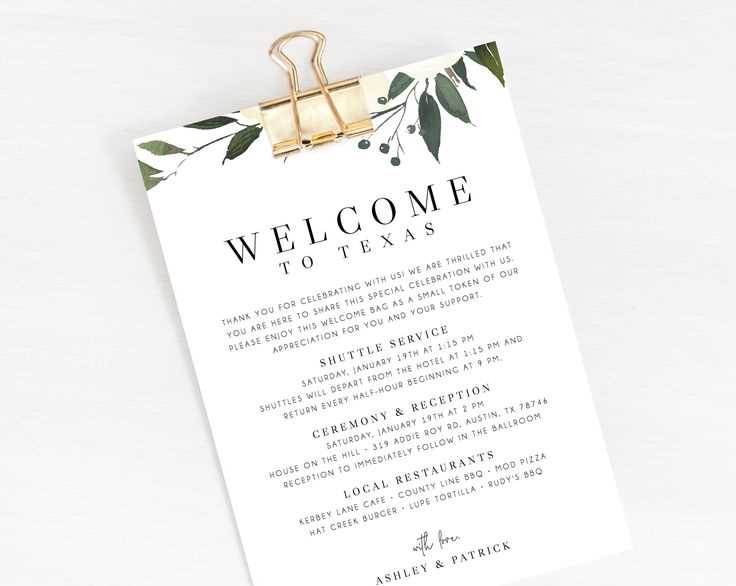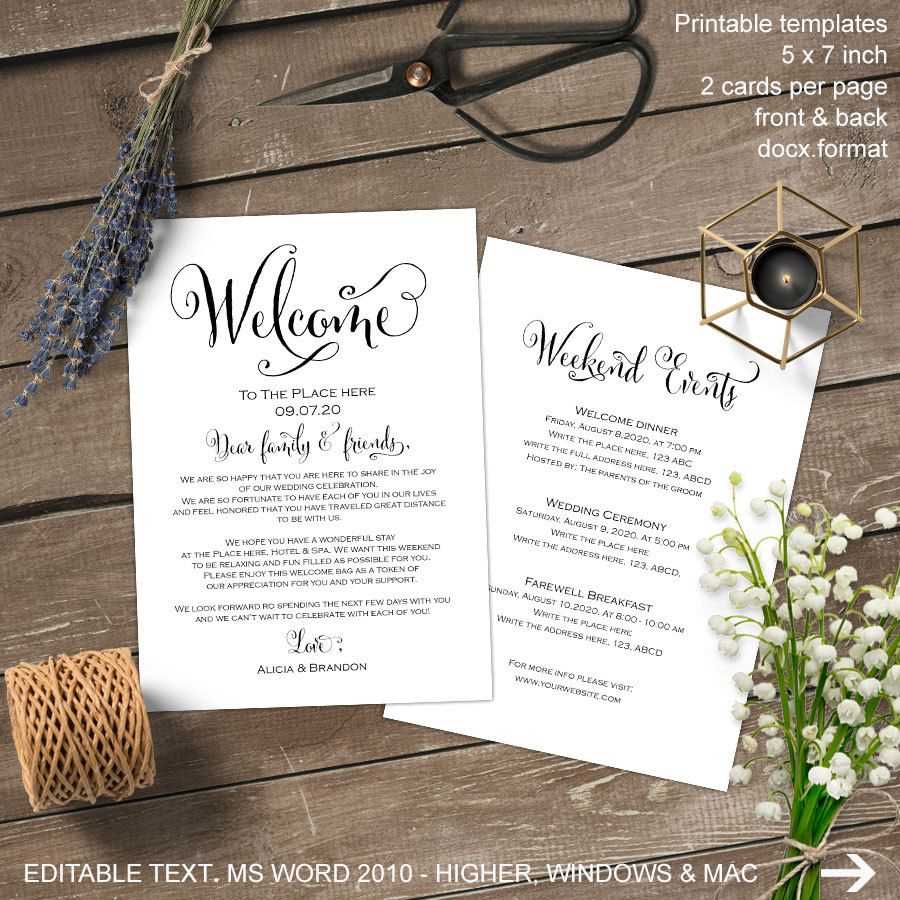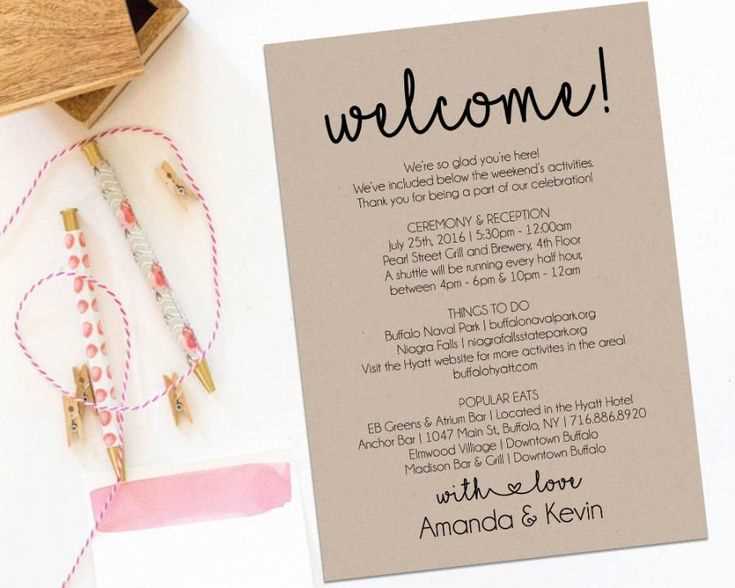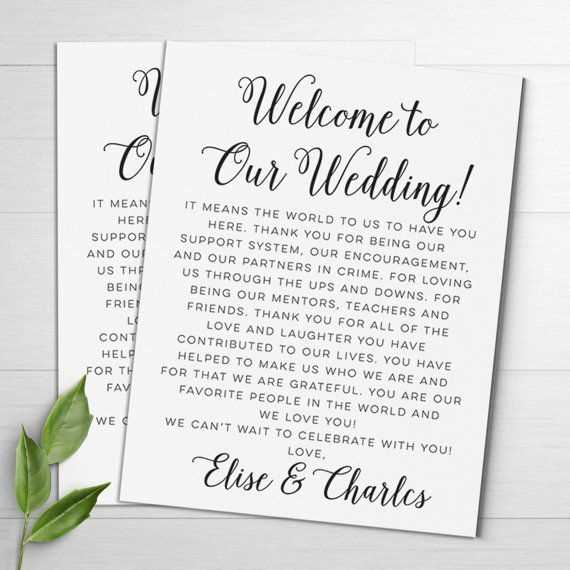Wedding guest welcome letter template

Welcome letters set the tone for a memorable celebration. Personalize your message to ensure it reflects the warmth and excitement of your event. Start with a friendly greeting that invites guests to feel at ease and excited for the festivities ahead.
Provide details on event logistics. Include information like the venue, parking instructions, and any special considerations. This ensures guests arrive ready to enjoy without confusion. Keep it simple and clear so everyone feels prepared for the day.
Express gratitude for your guests’ presence. Acknowledge their efforts to attend and share your joy. This personal touch strengthens your connection with each attendee, making them feel valued and appreciated.
Wedding Guest Welcome Letter Template
Begin with a warm greeting, expressing genuine excitement about the guest’s presence at the event. Address them directly, making it personal and welcoming.
Personalized Greeting
For example, “Dear [Guest Name], we are delighted that you’ll be joining us on this special day!” This establishes a connection and sets the tone for the rest of the letter.
Event Details
Include brief yet specific details about the ceremony and reception, such as the time, venue, and any essential instructions. For instance, “The ceremony will start at [time], followed by the reception at [venue]. Please note that parking is available on-site.” This keeps guests informed without overwhelming them.
Close with another thank you and a reminder that their presence is cherished. For instance, “We can’t wait to celebrate with you and look forward to seeing you soon!” This provides a heartfelt finish to the letter.
Personalizing Your Welcome Letter for Wedding Guests
Address your guests by name to immediately make them feel valued. Start with a warm, personal greeting that matches the tone of your wedding. Instead of a generic opening, consider a small note reflecting your relationship with the guest or a shared memory.
Tailor the Content
Use the letter to give specific details that show you’ve thought about your guests. Mention details like the location of the event, accommodations, or travel tips. If certain guests are traveling a long distance, offer a helpful list of nearby attractions or a guide to the local area. This makes the letter more than just a formal note, but a personalized guide for their visit.
Share a Special Message
Consider adding a personal anecdote or a touching statement about how much it means to have them at your celebration. A sincere message, like how their presence adds to your special day, can make the letter more memorable and meaningful for them.
Choosing the Right Tone: Formal or Casual?
Decide on the tone based on the overall atmosphere of the wedding and the relationship you have with your guests. If the event is elegant and traditional, opt for a more formal style. Keep your language polished and respectful, addressing guests with proper titles and using full sentences. If the wedding is more relaxed and laid-back, feel free to choose a casual tone. Use conversational language, and include a warm and personal touch. Let your guests know you’re excited to celebrate with them in an informal, friendly manner.
Formal Tone
A formal tone is appropriate for a classic, upscale celebration. Use complete sentences, polite greetings, and respectful language throughout the letter. This tone suits a black-tie event or a ceremony in a traditional venue. Phrases like “We are honored to have you” or “Please join us” convey the right amount of formality.
Casual Tone
A casual tone works well for a more relaxed celebration, like a beach wedding or casual reception. You can use a friendly greeting like “We can’t wait to celebrate with you!” and be more creative with your wording. Personal anecdotes or light humor can also help set a comfortable, welcoming tone for your guests.
What Key Information to Include in the Letter
Start with a warm greeting that makes the guests feel welcomed and appreciated for attending. Mention the couple’s names and express gratitude for their presence at the event. This sets a personal tone and helps guests feel special.
Details about the Event
Provide essential information about the wedding ceremony and reception. Include the date, time, and location of each event, as well as any special instructions. If there are multiple venues or scheduled activities, make sure these details are clear to avoid confusion.
Information about the Schedule
Outline the timeline of the day, including when guests should arrive, the start time of the ceremony, and any other key events such as speeches, meals, or entertainment. This helps guests plan and manage their time more effectively.
Don’t forget to mention any dress code or themes for the wedding. If there are specific guidelines, let guests know what attire is expected, from formal wear to casual dress codes, ensuring everyone feels prepared.
Conclude by offering a reminder about RSVPs and any relevant details about gifts or other pre-wedding requests. Express your excitement for their presence, making them feel more connected to the celebration ahead.
Design and Layout Tips for a Polished Appearance
Choose a clean, elegant font. Avoid overly decorative styles that may distract from the message. Opt for classic serif or sans-serif fonts, which maintain readability while giving your letter a refined touch.
- Balance text and space: Ensure there’s enough white space around your text to avoid a cluttered appearance. Leave adequate margins, and use line breaks to give each paragraph breathing room.
- Consistent alignment: Align your text in a way that feels cohesive. Stick to left or center alignment for a more uniform look across your layout.
- Headers and subheaders: Use them to break up sections clearly. They act as visual cues for readers, making your letter easier to scan.
- Color scheme: Choose a limited palette of soft, neutral tones. Stick to two or three complementary colors to maintain sophistication. Use color sparingly, mostly for headers or accents.
Incorporate decorative elements subtly. A tasteful border or floral motif in the corners can elevate the design without overpowering the content. Keep these accents minimal and refined to maintain a clean, polished appearance.
Finally, proofread for clarity. Ensure the layout supports the readability of the content. A polished design is not only about appearance but also about creating an easy, pleasant reading experience.
Including Additional Touches: Gifts or Special Instructions
To enhance your guests’ experience, consider including thoughtful gifts or special instructions in the welcome letter. These small gestures create a memorable impression and show your appreciation for their attendance.
Personalized Gifts

- Provide each guest with a small token, such as a custom-made keychain, personalized fan, or locally crafted item. This adds a personal touch and makes them feel valued.
- Include a thank-you note with each gift, mentioning how much their presence means to you.
Special Instructions

- If the venue requires specific attire, such as formal dress or comfortable shoes, communicate this in the letter to avoid confusion.
- Provide directions to the event location, parking details, and any other logistical information to ensure a smooth arrival.
- If there are any surprises or special moments planned during the event, hint at them without giving everything away to keep guests intrigued.
How to Distribute the Welcome Letters to Guests
Distribute welcome letters to guests by placing them at key points where they’ll be easily noticed. The main options include individual envelopes at the entrance or placement on each guest’s seat. Tailor this decision based on the formality of the event and the available space.
At the Venue Entrance
Position welcome letters at the entrance, so guests can collect them as they arrive. This method works well for larger events and ensures that no guest misses the letter. Have an attendant available to help guide guests to the letter station.
On Guest Seats

For a more personal touch, place the letter on each guest’s seat before they arrive. This ensures the letter is waiting for them when they take their place. It’s a great way to make guests feel welcomed and appreciated from the moment they sit down.
| Method | Pros | Cons |
|---|---|---|
| At the Entrance | Accessible to all guests, allows easy distribution | Requires space for a letter station |
| On Guest Seats | Personal touch, immediate access | Can be time-consuming to arrange for large events |
Whichever option you choose, ensure the letters are neatly arranged and easy to spot, helping guests feel welcomed right from the start.